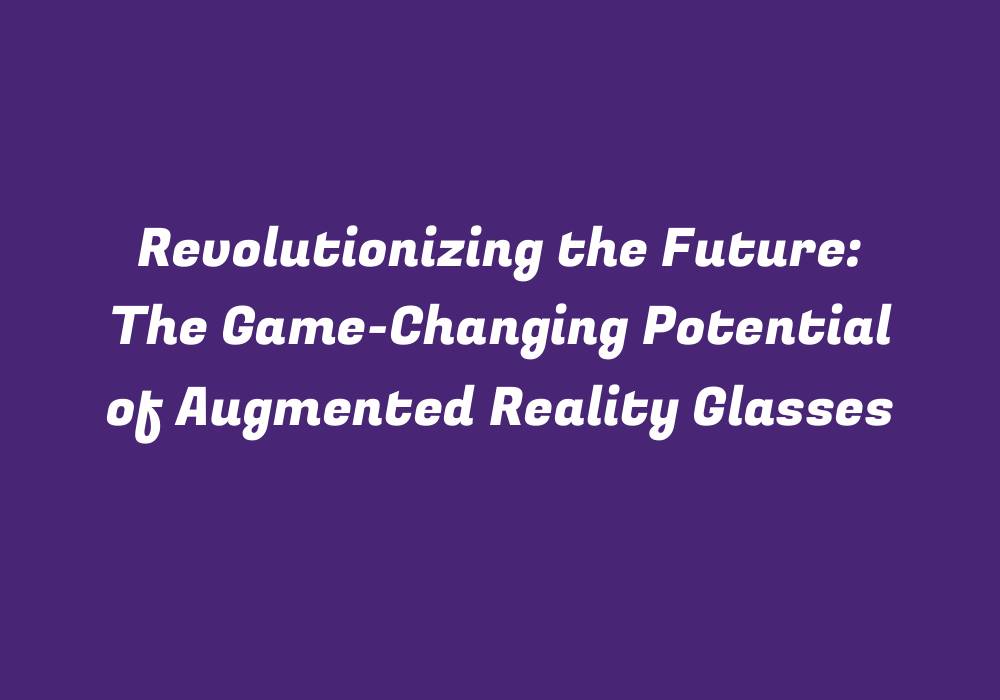Introduction
Augmented reality (AR) has the power to revolutionize our world in ways that were once only imagined in science fiction movies. With its recent advancements, this technology is making significant strides towards changing the way we live, work and communicate with one another. Amongst various AR tools, augmented reality glasses are quickly becoming game-changers that have the potential to transform industries and our daily lives like never before.
How Augmented Reality Glasses Work
Augmented reality glasses consist of a combination of computer technology, digital imagery, and real-time sensory input. They can seamlessly blend virtual objects into the user’s real-world surroundings by tracking the environment through built-in sensors such as cameras, motion trackers, and infrared depth sensors. By creating a new layer of information on top of reality, AR glasses enable users to interact with their surroundings in an entirely different way.
Revolutionizing Education
One industry that will benefit greatly from the integration of AR glasses is education. With the ability to superimpose virtual content over real objects and scenarios, these devices can transform how students learn, providing a more immersive experience in both classroom and self-study settings. For instance, teachers could use them to display complex scientific concepts or historical events in real-time, making it easier for students to comprehend and engage with difficult subjects.
Enhancing Workplace Productivity
Augmented reality glasses have the potential to revolutionize workplace productivity by streamlining communication and increasing efficiency. For example, construction workers could wear AR glasses that display real-time data about a building’s blueprint, making it easier for them to perform their tasks correctly and in a more timely manner. Similarly, doctors might benefit from using these glasses during surgeries to access critical patient information hands-free, leading to improved patient care and safety.
Transforming the Retail Experience
AR glasses could significantly alter how consumers shop by providing personalized recommendations and instant purchasing options based on their preferences or even physical attributes. In retail stores, they might allow customers to virtually try on clothing before making a purchase, eliminating the need for changing rooms and reducing waste from returned items. Additionally, AR-enabled smart mirrors could display virtual mannequins that adapt to each shopper’s body shape, making it easier for them to choose the perfect fit.
Enriching Gaming Experiences
The gaming industry has long been a driving force in developing AR technology, and now it is on the verge of entering an era where physical boundaries will no longer limit gameplay. With AR glasses, players can immerse themselves in virtual worlds seamlessly integrated with their environment, allowing for new levels of interaction with games that were previously unimaginable.
Improving Navigation and Mobility
AR glasses could revolutionize navigation by providing real-time information on routes and destinations directly in a user’s field of view. This technology would significantly reduce the need for paper maps or GPS devices, making it easier to navigate unfamiliar environments and potentially minimizing the risk of accidents or getting lost. Furthermore, they may even help people with visual impairments by offering auditory guidance and alerts for obstacles in their path.
Revolutionizing Medical Treatment
The use of AR glasses in the medical field has numerous potential benefits, such as assisting surgeons during complex procedures or guiding therapists through rehabilitative exercises. By providing real-time data and visual cues, these devices could enhance surgical precision, reduce the risk of complications, and improve patient outcomes overall. Moreover, they may also enable clinicians to monitor patients remotely, ensuring their wellbeing even when they are away from the hospital or clinic.
Promoting Environmentally Sustainable Practices
Augmented reality glasses could help raise public awareness about environmental issues and encourage sustainable practices by providing real-time data on air pollution levels, water usage, and carbon emissions. This technology could potentially facilitate smarter urban planning, assisting in the creation of more eco-friendly cities that prioritize energy efficiency and reduce waste production.
Conclusion
As augmented reality glasses continue to evolve and become more widely available, it is clear that they have the potential to revolutionize our lives across numerous industries and applications. By combining digital imagery with real-world environments, these devices promise to bring about a new era of innovation and transformative experiences that will change the way we interact with our surroundings. As they continue to develop, AR glasses hold the key to unlocking a future where technology blends seamlessly with reality, improving communication, collaboration, and overall wellbeing for all.
